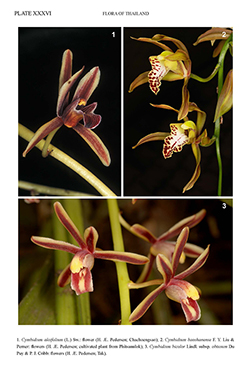e-Flora of Thailand
Volume 12 > Part 2 > Year 2014 > Page 447 > Orchidaceae > Cymbidium
3. Cymbidium baoshanense F.Y.Liu & Pernerwfo-0000934319
Orchidee (Hamburg) 52: 61, figs s.n. on pp. 61–64. 2001; Z.J.Liu et al. in Z. Wu et al. (ed.), Fl. China 25: 273. 2009. Plate XXXVI: 2.
Accepted Name : This is currently accepted.
Description : Medium-sized, epiphytic herb. Pseudobulbs 5–7 by 1.6–2.9 cm, slenderly ovoid, slightly bilaterally flattened. Leaves 5–7 per pseudobulb, subsessile, 7.4–53.9 by 1.6–3.7 cm, oblong-lanceolate to narrowly linear-oblanceolate, acuminate, mucronate, coriaceous, arching. Inflorescence ca 70 cm long, arcuate, with ca 11 flowers; rachis ca 30 cm long; bracts 7–23 mm long. Flowers 8–9 cm across, weakly and rather unpleasantly scented; sepals and petals olive-green to olive-brown, petals with dark purple dots at base; labellum mainly cream with dark purple spots on mid-lobe and distal part of side lobes, disk white with dark purple markings at base and mainly white ornaments with dark purple mid-line and minutely purple-dotted keels. Dorsal sepal 53–55 by 12–14 mm, oblanceolate, acuminate, minutely mucronate, incurved; lateral sepals similar, oblique, acute, spreading. Petals 49–51 by 10–11 mm, obliquely oblanceolate, acuminate, spreading, slightly incurved. Labellum 34–37 by 30–32 mm when flattened, finely papillose on the ventral side, usually fused to column at the very base; side lobes very obliquely triangular-oblong, rounded, slightly exceeding the column and anther; mid-lobe 16–17 by 16–17 mm, broadly ovate, acuminate, with somewhat raised, undulate sides; ornaments of 2 well-defined, almost parallel ridges extending from the base of the labellum to the base of the mid-lobe. Column 32–34 mm long; pollinia 2.
Thailand : NORTHERN: Phitsanulok (Phu Soi Dao – Suphuntee et al. 805 -BKF QBG).
Distribution : Yunnan (type).
Ecology : Hill evergreen forests. Flowering: August.
Notes: This taxon is newly recorded for Thailand. Emphasizing the marked variability of Cymbidium baoshanense and its overall morphological intermediacy between C. lowianum (Rchb.f.) Rchb.f. and C. tigrinum C.S.P.Parish ex Hook., Du Puy & P.J.Cribb (2007) proposed that it might be a hybrid between the latter two. Cymbidium baoshanense indeed resembles the artificial hybrid of the same parentage (Liu et al., 2009), so a closer systematic study is called for.
E-version notes : As Cymbidium × baoshanense F.Y.Liu & Perner

